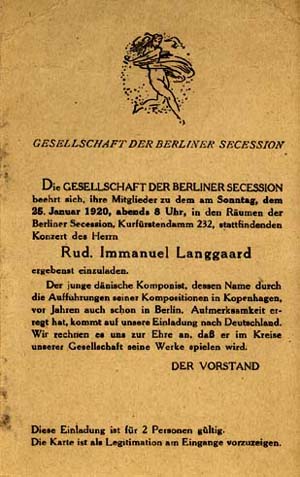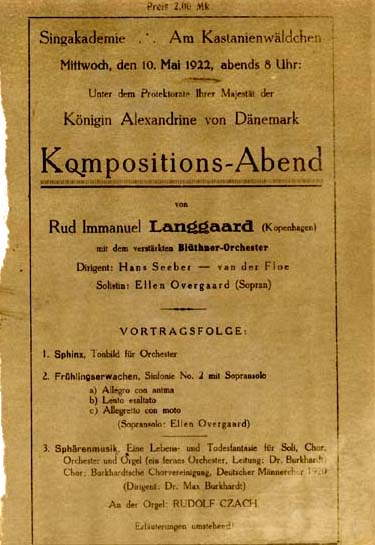Langgaard's Europe
Berlin
Every year in the period from 1908/09 to 1912/13, Rued Langgaard and his parents visited Berlin in the months of December or January. They went to all the concerts and opera performances they could manage, and learned about the new music, including that of Richard Strauss, which at that time was not yet known in Denmark. Langgaard was allowed to attend the rehearsals of the Berlin Philharmonic, and in the end his parents and relatives engaged the orchestra and the conductor, Max Fiedler, to perform a concert dedicated to the works of Langgaard, which took place on 10.4.1913.

Langgaard's first public appearance in Germany after the First World War was on 25.1.1920, when the
Gesellschaft der Berliner Secession had invited him to a composition evening. Along with the concert singer,
Ellen Overgaard, with whom he often appeared in Germany in the following years, he performed vocal works and the
piano suite, Gitanjali-Hymner (Gitanjali Hymns).
In 1921-25, the German conductor, Hans Seeber van der Floe, made an effort to launch Langgaard in Germany. He performed the Symfonisk Festspil (Symphonic Festival Play) in Berlin in 1922, and in the same year conducted a Langgaard concert in the town. This concert offered a repetition of Sfærernes Musik (Music of the Spheres), which had been performed for the first time by van der Floe in Karlsruhe in 1921.
 The concert in Berlin
on 10.5.1922 took place under the patronage of the Danish Queen, Alexandrine. She was German by birth, and had
previously been the patroness of a Langgaard concert in Berlin in 1913.
The concert in Berlin
on 10.5.1922 took place under the patronage of the Danish Queen, Alexandrine. She was German by birth, and had
previously been the patroness of a Langgaard concert in Berlin in 1913.
The 1922 concert was given a mixed reception, but the following year the Blüthner Orchestra which had played at
the concert choose to play the first performance of Langgaard's 6th Symphony at a guest performance in
Copenhagen - a performance that was very close to being a scandal.
![]()